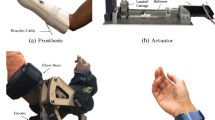Abstract
Sensory feedback has been used, by a number of workers, to inform the central nervous system of the present state of an artificial limb. Although both electrical stimulation and electromechanical vibrations have been used, there appears to be no evidence of a direct comparison of the advantages and disadvantages of these methods. Such a comparison is made here. It is shown that the information transmission capabilities of both systems are more or less identical. The electrical system has some advantages in reducing the number of items in a myoelectric control system with feedback, but the mechanical vibration system has the advantage of a universal psychological acceptance.
Crosstalk prohibits the use of two electrical feedback, channels and it is recommended that, where two channels are required, one should be electrical and the other a mechanical vibration.
Sommaire
Plusieurs chercheurs ont utilisé la rétroaction sensorielle pour informer le système nerveux central de l'état actuel d'un membre artificiel. Bien que la stimulation électrique ainsi que les vibrations mécaniques aient été utilisées on semble ne trouver aucune preuve d'une comparaison directe des avantages et désavantages de ces méthodes. Le présent article fait cette comparaison. On montre que la capacité de transmission des informations par les deux systémes est plus ou moins identique. Le système électrique possède quelques avantages en réduisant le nombre des pièces du système de controle myoélectrique rétroactif alors que le système a vibrations mécaniques possède l'avantage de son myoélectrique rétroactif alors que le système à vibrations méchaniques possède l'avantage de son acceptabilité psychologique universelle. La communication croisée empêche l'usage de deux canaux rétroactifs électriques et on recommande que dans les cas où deux canaux sont nécessaires, l'un d'eux soit électrique et l'autre à vibrations mécaniques.
Zusammenfassung
Die Rückführung der Sinneswahrnehmungen wurde von mehreren Forschern dazu benutzt, das zentrale Nervensystem über den derzeitigen Zustand eines küstlichen Gliedes zu informieren. Obgleich sowohl die elektrische Stimulation wie auch elektromechanische Schwingungen verwendet wurden, schienen keine Beweise für einen direkten Vergleich von Vorteilen und Nachteilen dieser Verfahren vorzuliegen. Ein solcher Vergleich wird hier angestellt. Es wird gezeigt, daß die Möglichkeiten Systeme, Informationen zu übertragen, mehr oder weniger gleich sind. Das elektrische System hat gewisse Vorteile, da es die Anzahl der Elemente in einer myoelektrischen Steuerung mit Rückkoppelung senkt Das mechanische Schwingungssystem hat den Vorteil, daß es psychologisch universell Annahme findet. Durch Kopiereffekt wird die Verwendung von zwei, elektrischen Rückkoppelungskanälen ausgeschlossen. Es wird empfohlen, daß dort, wo zwei Kanäle erforderlich sind, ein Kanal elektrisch, der andere ein mechanischer Schwingungskanal sein sollte.
Similar content being viewed by others
References
Alles, D. S. (1970) Information Transmission by Phantom Sensations.IEEE Trans. MMS 11, 85–91.
Keeker, Th. W., During, J. andDen Hertog, A. (1967) Artificial Touch in a hand prosthesis.Med. Biol. Eng. 5, 47–49.
Bekesy, G. Von (1957) Neural volleys and similarity between some sensations produced by tones and by skin vibrators.J. Accoust. Soc. Amer. 29, 1059–1069.
Bekesy, G. Von, (1959) Similarities between hearing and skin sensations,Psychol. Rev. 66, 1–22.
Davey, E. C. (1974) A myoelectrically controlled arm prosthesis with sensory feedback sharing common electrodes. M.Sc.E. Thesis, UNB.
Davey, E. C. andShannon, G. F. (1974) Sensory feedback. Progress Report No. 13, Myoelectric Control Systems, Bio-Eng. Institute, University of New Brunswick.
Geldard, F. A. (1957) Adventures in tactile literacy.Am. Psychol. 115–24.
Hahn, J. F. (1958) Cutaneous vibratory thresholds for square wave electrical pulses.Science 127, 879–80.
Hiertonn, T. (1967) An above elbow prosthesis with e.m.g. controlled prehension. Digest 7th ICMBE, Stockholm, 457.
Kato, I., Kumamoto, M., Tamura, S. andTsunekawa, Y. (1970) Human's congenital ability for electric stimulation signals. Advances in External Control of Human Extremities, Yugoslav Committee for Electronics & Automation, Belgrade.
Kato, I., Ohara, Y., Okazaki, K. andIchikawa, K. (1972) Electric upper arm type prosthesis with pressure sensitivity: The waseda hand Mk. 5. Biomechanisms, Tokyo, 199–206. [NRC Canada 1974 Technical Translation 1769].
Mann, R. W. (1969) The basic problems of prehension movement and control of artificial limbs.Proc. I. Mech. E. 31, 183.
Mann, R. W. andReimers, S. D. (1970) Kinesthetic Sensing for the emg controlled Boston arm.IEEE Trans.,MMS 11.
Prior, R. E. andLyman, J. (1974) Electrocutaneous feedback for artificial limbs. Quarterly Progress Report No. 54, Biotechnology Lab., UCLA.
Rohland, T. A. (1972) Sensory feedback system for a myoelectrically controlled arm prosthesis. M.Sc.E. Thesis, UNB.
Rohland, T. A. (1974) Sensory feedback in upper limb prosthetic systems. Inter Clinic Information Bulletin 13, 1–4.
Schmidl, H. (1974) The importance of sensory information in upper limb prostheses. World Congress of the International Society for Prosthetics and Orthotics, Montreux, Switzerland, October.
Shannon, G. F. (1974) Characteristics of a transducer for tactile displays.Biomed. Eng. 9, 247–249.
Shannon, G. F. (1975) The case for sensory feedback on artificial limbs.Elect. & Mech. Trans. IE Aust. EE 11, 40–45.
Sueda, O. (1972) Evaluation of sensation apparatus for hand prosthesis and controllability of hand prosthesis.Biomechanisms, Tokyo, 171–184. (NRC Canada 1974 Technical Translation 1768).
Author information
Authors and Affiliations
Rights and permissions
About this article
Cite this article
Shannon, G.F. A comparison of alternative means of providing sensory feedback on upper limb prostheses. Med. & biol. Engng. 14, 289–294 (1976). https://doi.org/10.1007/BF02478123
Received:
Accepted:
Issue Date:
DOI: https://doi.org/10.1007/BF02478123




